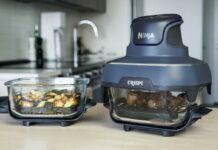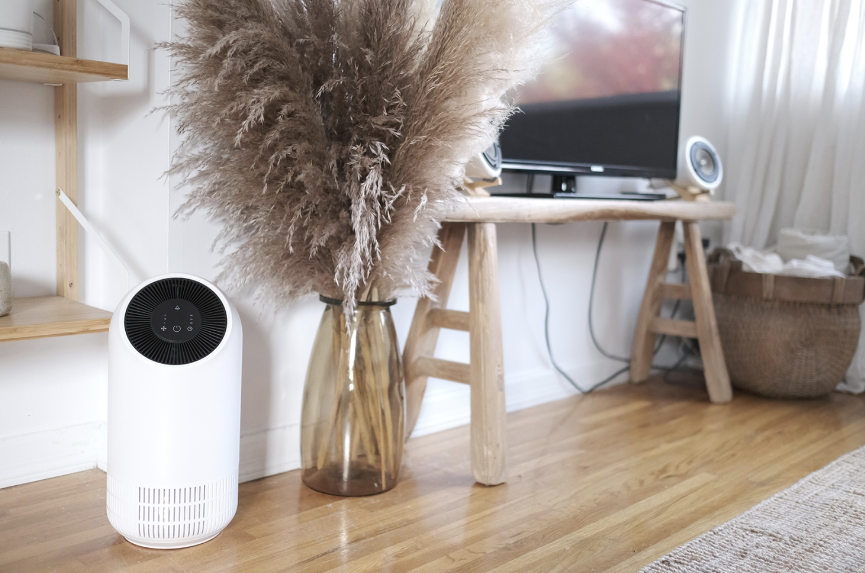
Air purifiers are important small home appliances to help you breathe clean air in the home. They work to help get rid of bacteria, dust mites, mold, viruses, odours, and other volatile organic compounds (VOCs), and even rid the home of odours, including everything from paint and cleaning chemicals to pungent cooking smells.
In this comprehensive guide, we’ll walk you through everything you need to know about air purifiers, the different types that are available, filter maintenance, care, and unique features to help you choose the right one for you and your family.
Table of Contents:
What are air purifiers?
Air purifiers, available from brands like Blueair, Danby, Dyson, GermGuardian, Honeywell, and Levoit, are small appliances designed to help remove pollutants from the air in your home (or office space), leaving you with fresher, cleaner air to breathe. This can include dust mites, mold, pet dander, bacteria, viruses, household chemicals, and other volatile organic compounds (VOCs). While air purifiers are most useful for those who suffer from allergies, asthma, and other respiratory conditions, they can be beneficial for anyone.
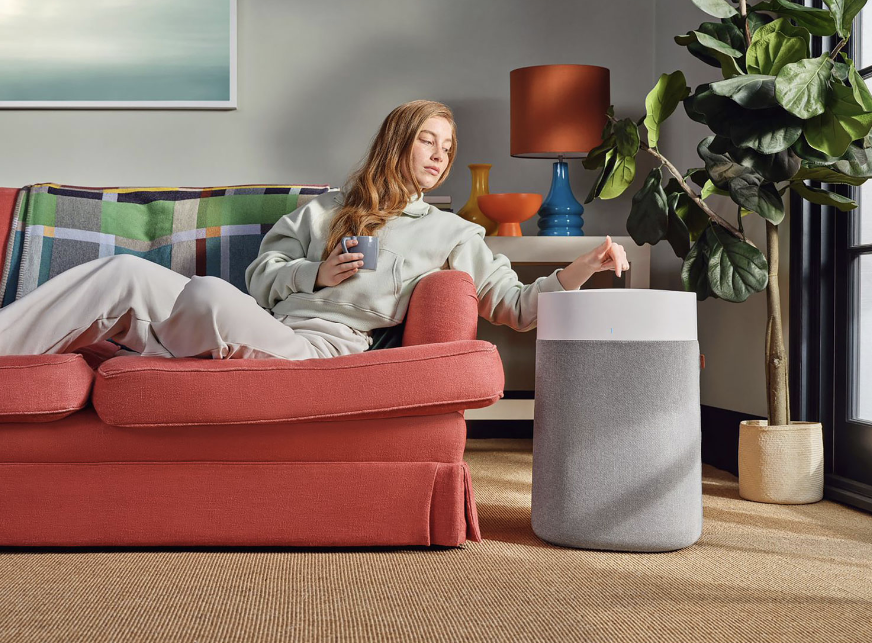
Air purifiers either to sit on the floor or other flat surface, like a shelf, table, or desk. Along with larger models designed to clean the air in an entire room, or even floor of the home, there are also portable, personal air purifiers you can use on your desk at the office, for example. They operate manually or some can function in an automatic mode, even on a schedule. The latest models sync with mobile apps so you can monitor the air quality in your home from anywhere.
How do air purifiers work?
Every air purifier contains a filter, often multiple filters that, along with a fan, help trap pollutants then recirculate cleaner air in the home. It’s that simple! The process continually works, pulling in pollutants and pushing out cleaner air, improving the indoor air quality over time.
Plug the machine into a standard power outlet, turn it on, then adjust speed settings, purification options, and let it do its thing.
The main types of air purifiers
There are a few main types of air purifiers from which you can choose, with the best air purifiers offering multiple filters.
1. HEPA (High-Efficiency Particulate Air) air purifiers
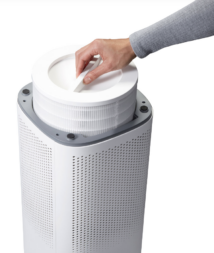
Many air purifiers commonly include HEPA filters, which are the most effective type at trapping ultra-small particulates in the air. They purport to capture up to 99.97% of particles as small as 0.3 microns in size, which can range from dust to pollen, bacteria, and smoke.
A HEPA filter is made of pleated mechanical material that is a specific thickness to effectively capture those particulates. The fibres are randomly and densely arranged such that they can capture all types of particles, even those of miniscule size. They use a combination of diffusion, interception, and impaction to accomplish this.
2. Activated carbon filter air purifiers
The best air purifiers will combine both a HEPA filter with an activated carbon filter. These types of filters are made of pieces of carbon, constructed into a granular or powdered block that has been treated to be porous. This absorbs contaminants and allergens when the organic compounds in the air react to the activated carbon.
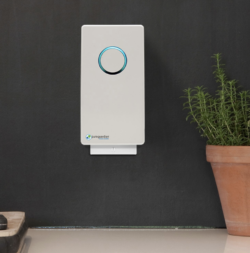
Activated carbon filters are particularly effective at trapping unpleasant odours, chemicals, and gases from the air. But as noted, they work best in combination with a HEPA filter as well.
3. UV-C light purifiers
A completely different type of air purifier is a UV-C light purifier, which uses short-wave ultraviolet lights to kill germs, viruses, bacteria, and other pollutants in the air. When air goes through the device, it passes through a UV lamp that works to disinfect the air using this process known as germicidal irradiation. These air purifiers aren’t generally as effective as air purifiers with HEPA and activated carbon filters, and are most often uses alongside those machines, or contain HEPA filters as well.

4. Ionic air purifiers
A less common type of air purifier is an ionic air purifier, typically found in smaller, more portable sizes. These emits negative ions into the air to attract the positive charged airborne particles. But they can product trace amounts of ozone, and also irritate lungs. For this reason, while ionic air purifiers are usually more affordable, they are the least popular of the bunch. These are also not recommended for those who suffer from respiratory issues.
What are the benefits of an air purifier?
An air purifier, as you know, cleans the air. But what can this cleaner air do for you? It turns out, there are a lot of reasons you’d want an air purifier.
1. Breathe cleaner air overall
The most obvious benefit to air purifiers is that they help you breathe cleaner, fresher air that’s free of pollutants, bacteria, viruses, mold, dust mites, pollen, and smoke. Being able to breath in fresher air overall is good for everyone, not just allergy or asthma sufferers. It’s ideal, especially, if you have young children or elderly family members in the home who might be more sensitive to illnesses and picking up viruses.
2. Helpful for those with allergies, asthma
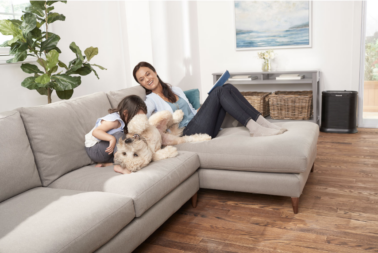
If you suffer from allergies or asthma, even a small amount of dust, mold, or pollen can trigger symptoms. An air purifier can help, especially during times when the pollen count is high, and you want to keep the windows open. If you have pets and suffer from allergies, an air purifier can make living with your precious pup or cute cat manageable by cleaning the air of their pet dander.
3. Helps reduce odours
As mentioned, an air purifier doesn’t just rid your space of dust, pollen, bacteria, and viruses, but also smells. They can help get rid of smells like paint and other chemicals after a home renovation, or pungent cooking smells in the kitchen when you whip up a fresh batch of homemade curry. If someone smokes in the home, an air purifier can help eliminate that smell, while room like a basement, can benefit from the elimination of that musty smell floating in the air.

4. Helps improve sleep
Breathing cleaner air can actually help improve your sleep. Rather than being up coughing all night due to dust particles in the air, which can exist even after you clean the home, or sniffling away due to pollen from the open window, an air purifier can help you sleep better. The steady sound can also be soothing for some.
5. Reduces the transmission of airborne diseases
Diseases and viruses for everything from the common cold to the flu can travel through the air, and having an air purifier in the home might make it less likely that everyone in the family gets sick when one person does. It can help to suck up those airborne diseases before they reach your own nasal passages, or you end up breathing them in.
6. Contributes to healthier lungs
Lung health is important, and pollutants, mold, dust, and other bacteria in the air can impact your overall lung function. Being able to breathe cleaner air can help your lungs function more efficiently. The American Lung Association notes outright that “clean air is essential for healthy lungs.” An air purifier helps you get that inside your home.
What size air purifier should you get?
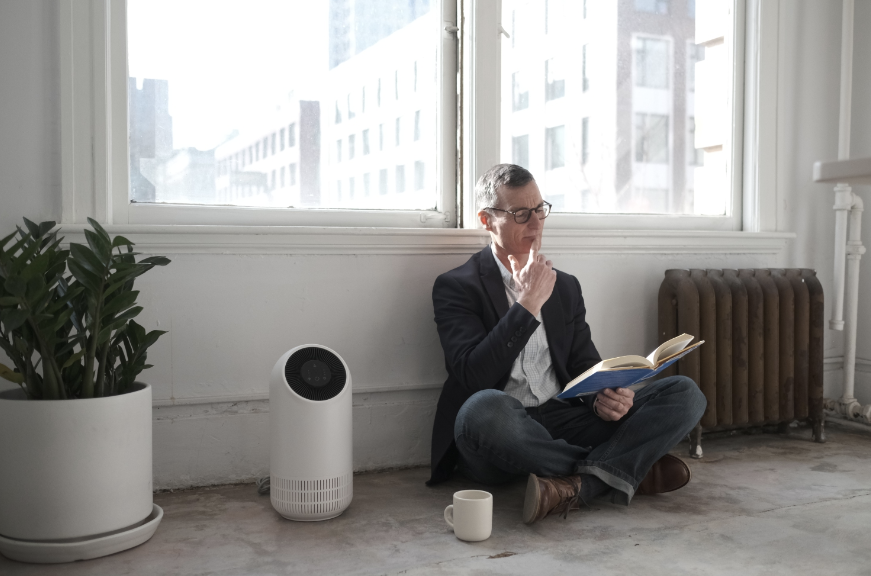
Air purifiers don’t only come in various types, they also come in different sizes. You’ll find floor-standing models that are wider and larger, some that are taller and slimmer. There are also tabletop models you can place on a side table, shelf, or even your office desk. How do you select the right size?
Generally, you’ll choose the size of air purifier based on the room or space in which you want to put it. Smaller air purifiers are great for rooms up to about 400 square feet in size. Look at a medium-sized air purifier for a room that’s anywhere between 400 and 600 square feet in size. Anything bigger than 600 square feet, like an open concept basement or living room, you’ll want to get a larger unit.
Most air purifiers will list the recommended room size on their labeling so you can use that as a guideline. But keep in mind that this doesn’t take everything into consideration. For example, if you have extra-high ceilings, you might want to go for something bigger.
What is a CADR number?
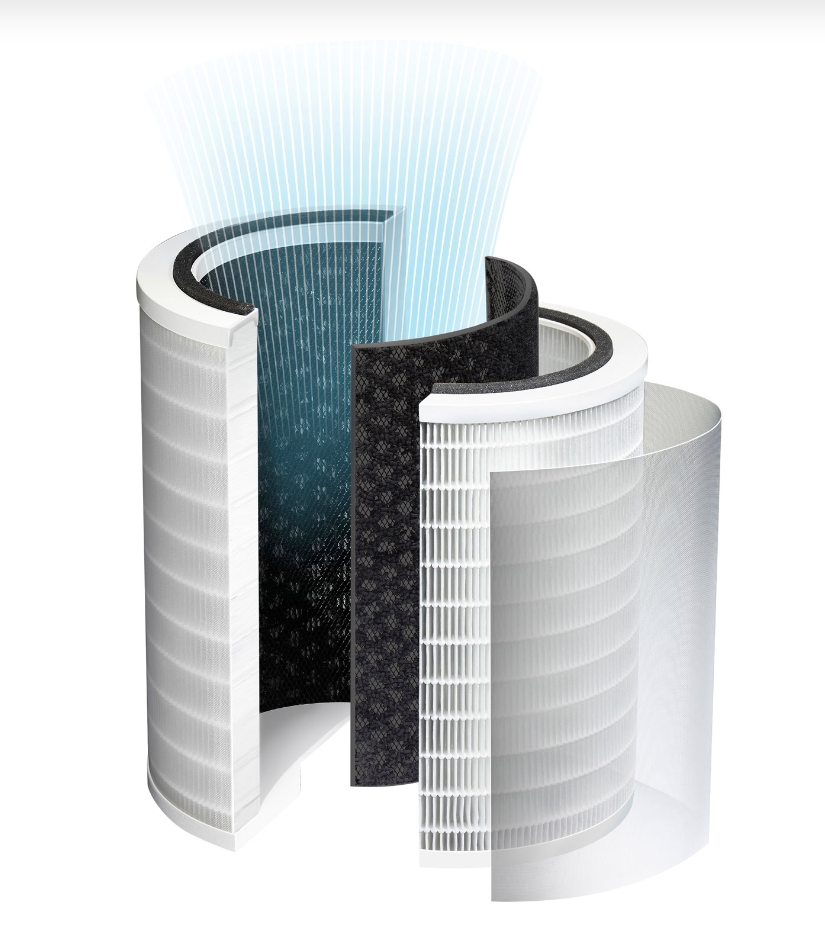
A better number to use to help determine what size or model would be best is the Clean Air Delivery Rate (CADR), which was developed by the Association of Home Appliance Manufacturers (AHAM). This numbers reflects how much air particulate the purifier can clean in cubic feet per minute. Machines are tested for removing smoke, pollen, and dust, and then assigned a CADR rating based on how they perform. The higher the CADR rating, the better an air purifier will be at cleaning air in a larger room and doing so more quickly.
If the air purifier you are considering has an official CADR rating, that’s a good sign that it has been tested and effectively graded to confirm its performance and efficacy in a room of a specific size. It’s also a great way to help you better understand which air purifier is best. Some might have high efficiency filters, for example, but low air flow, and thus wouldn’t sufficiently purify a room of your desired size.
To ensure maximum efficacy, opt for an air purifier that appears to cover a room larger than you think you would need. Also consider where the air purifier is going to go and how much space you have. If it’s in the corner of a small room, you might want a big model but prefer something thin and tall, so it neatly tucks away. For a larger, open concept room with lots of space, go with a bigger unit, especially if it’s easy to move around as needed.
What to look for in an air purifier
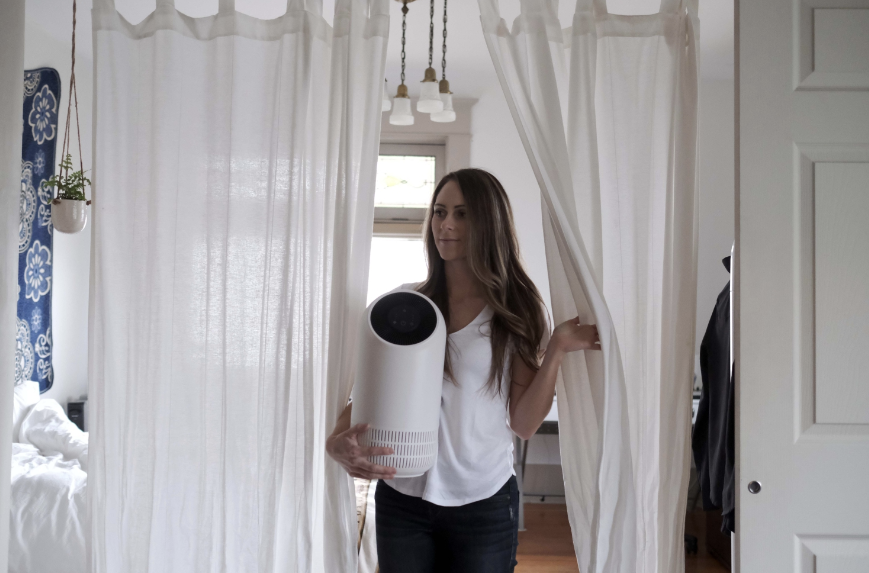
Size
Size is important not only related to the air purifier’s ability to efficiently clean the air in your home, but also so it fits with the décor and layout of the room. Know exactly where you’re going to place it before choosing a model. Measure the space to ensure the top of the unit won’t cover the bottom of a window, for example, or it won’t be a smidge too wide to fit beside the couch. Especially for smaller homes, apartments, or homes with lots of clutter, you’ll want to measure and visualize before choosing.
Air quality reporting and sensors
Air purifiers not only clean the air but ones with sensors can also provide real-time details about the quality of air via a menu on screen or, with smart models, in an app as well. Some are colour coded, so you might see a green light when the air is clean, yellow when it’s moderately dirty, and red when air quality is bad. This is a great way to alert you to when you might need to turn the purification up to a higher level or conversely, when you can turn it down. It’s also a nice way to continuously monitor the air quality in your home and get reassurances that you’re breathing in clean air.
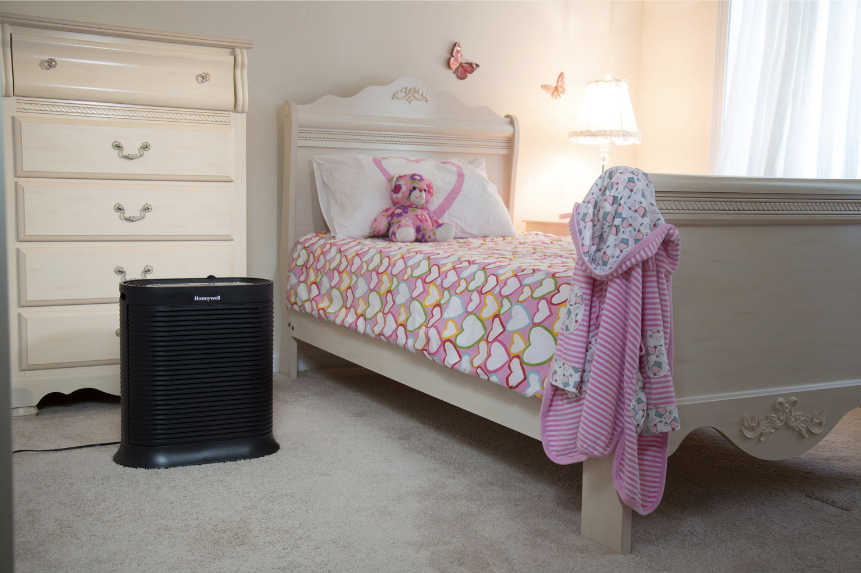
Speed settings
The best air purifiers have different speed settings so you can adjust based on what’s needed. Some can even automatically sense the quality of the air and trigger the appropriate fan speed as needed. For example, it might be running at a speed of 2 then crank up to 5 once you start cooking up a storm in the kitchen or painting the hallway. Otherwise, you can manually adjust the speed and level of purification, turning it up to high when allergy season is at its peak and down to low overnight.
Noise level
Air purifiers are typically like fans, and usually emit the same type and level of sound. The higher the speed you choose, the louder it will be. Naturally, you’ll want to make sure, however, that even at the highest speed, the air purifier won’t be distracting. You also want to know that you can comfortably run it on low at night, especially in a bedroom, and it won’t disrupt your sleep. The air purifier should be able to run at no more than about 50dB during the day, and you’ll probably want it closer to 30dB at night.
Timer functions
Some air purifiers have timers so you can set them to run for a few hours during the day then automatically shut off at night in case you forget to manually turn it off before you go to bed. This is a simple but appreciated convenience feature.
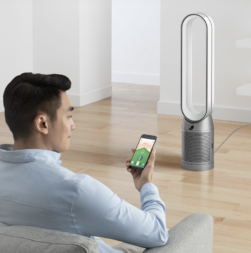
Smart features
Smart air purifiers connect to Wi-Fi or via Bluetooth to your phone. They can work with a mobile app and sometimes even voice control. You can control it remotely from your phone, or even verbally tell it to turn up to a level 4 speed or to turn on from across the room. The app provides details about the air quality and allows you to view a history so you can see if certain factors contribute to poor air quality, or air quality is poorer during certain times of the year. The app will usually also provide details about filter maintenance, advise when the filter needs to be changed, and sometimes even offer a one-touch option to buy a replacement.
Secondary features
Some of the latest air purifiers do more than just purify the air. They can also function as hot and/or cold fans and/or humidifiers. If you think you could make use of one of those secondary features, consider a dual-function model that can do more. An air purifier for a bedroom, for example, that can sit by the vent and help better circulate central air conditioning through its own built-in fan, could serve a useful dual purpose with one machine.
How to maintain an air purifier

Most air purifiers contain a replaceable filter that will usually last for about a year, depending on how often you use the machine and how hard it works to clean the air. You can buy a replacement filter in store or order one online and easily swap it out for the old one. Some have filters that can be cleaned, usually with a mix of warm soap and water.
Keep an eye out for a filter indicator light on the unit itself or, with smart models, in the app. This will advise you when it’s time to clean and/or replace the filter so you can get it done right away and keep the machine working as new. If you’re using a UV-C air purifier, you would need to replace the UV-C bulbs, likely as frequently as you would a HEPA filter.
Otherwise, the only other maintenance required for an air purifier is to wipe down its surface when you do a regular clean of the home and the room it’s in. Keep dust from accumulating on it, and check that it’s running efficiently. With proper care, an air purifier can last for years and years.
Take the next step

Ready to take the plunge towards cleaner air in your home? An air purifier is an investment that will pay dividends for your overall health and wellness. Use one daily in the home to keep the air fresh and clean. Set one up in the kitchen to pick up extra cooking fumes and smoke. Move it around while renovating the home to get rid of paint and other chemical smells. Keep one in the baby’s nursery or bedroom to ensure they aren’t breathing in viruses, bacteria, or dust mites. For a family member with allergies or household with pets, you’ll wonder how you ever lived without one.
See the wide selection of air purifiers at Best Buy Online.







